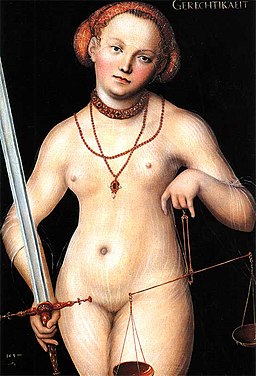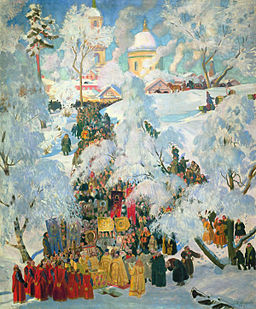I've been meaning to write another long how-to post for weeks. Here are just a few of the many, many ways to make magic water. All of them are quite unnecessary, but they're worth ploughing through because there's a party political broadcast at the end.HOW TO MAKE HOLY WATER IN THE ROMAN CATHOLIC TRADITION Lots of people have used lots of different ways for sanctifying water, but it was Catholic holy water I got asked about so I'm focusing on that one. Back in the old days, Catholic holy water was accounted a substance with real magical powers, so potent that it was kept locked up to stop it falling into mischievous hands. One of the interesting things about the Catholic Church is that a lot of what they did was straight-forward magic and they wanted to retain a monopoly on this magic. Their tactics included: writing everything down in Latin so people couldn't understand it, claiming that good magic could only be performed by their qualified practitioners, and that all other uses of magic were bad and should be pursued and punished.
That's why it doesn't matter how well you know the ritual for making holy water, it won't work for you unless you're a Catholic priest. And priests don't get their powers just by knowing stuff and going through a ceremony. That's also magic, and can only be transmitted to them through the rite of ordination, in a chain of transmission that connects them all the way back to St Peter and to Christ himself. There is not supposed to be any way of 'stealing' this power, although you could go ahead and become a bad priest and then misuse it. But, if you're not a priest, first you need to get one, and once you've got one, this is what he'll do/would have done:
- Exorcise all the dark forces out of some salt.
- Appeal to God to bless the salt and make it holy.
- Exorcise all the dark forces out of the water.
- Appeal to God to bless the water and make it holy.
- Add the salt to the water and stir thoroughly.
The exorcisms very much take the form of magic spells, since they address the substance directly and assume the priest holds within himself the power to bring about the desired effect. Here is one for salt (
see a complete but slightly different version of the rite from 1964):
O salt, creature of God, I exorcise you by the living God, by the true God, by the holy God, by the God who ordered you to be poured into the water by Eliseo the Prophet so that its life-giving powers might be restored. I exorcise you so that you may become a means of salvation for believers, that you may bring health of soul and body to all who make use of you, and that you may put to flight and drive away from the places where you are sprinkled every apparition, villainy, and turn of devilish deceit, and every unclean spirit, adjured by Him Who will come to judge the living and the dead and the world by fire.The blessing of the salt or water to make it holy depends on God, but it's assumed that he'll honor the priest's requests as a matter of course. While reciting the prayer and the exorcism, the priest will also make the magically powerful sign of the cross over the substance. This is the prayer for water:
O God, Who for the salvation of mankind has built Thy greatest mysteries on this substance, water, in Thy kindness hear our prayers and pour down the power of Thy blessing into this element, made ready for many kinds of purifications. May this, Thy creature, become an agent of divine grace in the service of Thy mysteries, to drive away evil spirits and dispel sickness, so that everything in the homes and other buildings of the faithful that is sprinkled with this water may be rid of all uncleanness and freed from every harm. Let no breath of infection, no disease-bearing air, remain in these places. May the wiles of the lurking Enemy prove of no avail. Let whatever might menace the safety and peace of those who live here be put to flight by the sprinkling of this water, so that the healthfulness, obtained by calling upon Thy holy name, may be made secure against all attack. Through our Lord Jesus Christ, Thy Son, Who lives and reigns with Thee in the unity of the Holy Spirit, God, for ever and ever.
After the Second Vatican Council, a lot of Catholic rites became less about actively changing the nature of substances and more about a symbolic getting in touch with the divine and letting God's power work through things and all that. The Council rather wanted to discourage those aspects of Catholicism which seemed to involve superstition, magic belief, and over-interest in supernatural entities such as ghosts, devils and even angels. Attention then shifted towards the question of whether holy water played a role in transmitting the more identifiable demons known as germs, rather than banishing the ineffable kind. Holy water is no longer locked up to keep it away from illicit practitioners of magic, but managed in such a way that it stays hygienic for users.
Meanwhile, traditional Catholics, priests and lay-people alike, have complained that the new rites are too Protestant, too symbolic and basically, have had the actual magic ripped out of them (see complaints
here and
here). It turns out that if you want traditional Catholic holy water these days, that first step of finding a priest to make it for you may be quite a challenge.
MAKING WATER INTO A MEDICALLY ACTIVE SUBSTANCE BY SHAKING ITHomeopathy is a system of medicine based on magic water, developed in 1796 by Samuel Hahnemann. Hahnemann believed that diseases were magic as were the curative properties of his remedies and so was water. More or less. The one thing that can be said for Hahnemann is that in an age where medicines were generally unproven, sometimes poisonous and usually bad for the patient, he saved lives by using plain old placebo water. Let's just hope he boiled it first.
Important disclaimer: homeopathy has no impact whatsoever on illnesses or discomforts beyond what can be achieved through psychological effects. For anything more serious than a common cold or feeling a bit down, see a medical doctor. This post is of satirical intent and should not be taken as medical advice. (Sheesh, the things you have to spell out for people...)Homeopathy is very, very complicated and requires long years of study, which is why its practitioners get to call themselves experts and charge lots of money for their fancy water. They have memorized a lot of stuff, which a lot of people before them have agreed to count as knowledge. For the benefit of the public, Magic for Skeptics offers an easy guide to DIY homeopathy, with an even easier quick-starter guide to follow.
1.
Psychological support: get a friend over and bribe them with beer to listen to you sympathetically while you talk about your symptoms. This is important: if you don't do this part right, you will lose out on the important psychological aspects of homeopathy. If you don't have a suitable friend, venting on the Internet may be better than nothing.
2.
Selecting a remedy: choose a substance which seems likely to cause the symptoms you're experiencing. In DIY homeopathy, please make absolutely sure to avoid the really poisonous substances, just in case (due to inexperience) you fail at the dilution stage of the process. Magic for skeptics recommends brandy as a good, traditional remedy for most purposes. There are few symptoms it can't produce under the right circumstances and if you don't
like brandy, so much the better, because you won't be drinking any.
3.
Dilution: Hahnemann's big insight was that if you dilute a poison enough, you'll end up with a harmless liquid. This is the key to safe homeopathy. To begin your dilution, place 1(one) centilitre of brandy in a litre of water.
4.
Succussion: ignore what all the homeopathic textbooks have to say on succussion. It really doesn't matter one bit how you do it, trust me on this, just give the stuff a good shake.
5.
Repeat repeatedly: take one centilitre from your water and brandy mixture and add it to another litre of water, then shake again. Repeat this whole process 12 times altogether. You will now have a solution of brandy which is quite unlikely to contain any brandy at all.
6.
Dosage: drink one teaspoonful of your dissolved brandy and believe. The believing part is very important, failure to do this interferes with the placebo effect of the remedy.
Here is the shorter (and recommended) version:
1.
Psychological support: get a friend over and bribe them with beer to listen to you sympathetically while you talk about your symptoms.
2.
Dosage: drink either one large glass of water or one small glass of brandy according to choice and believe.
This shorter version of the brandy method was practiced with great success by my grandfather throughout his life, so it must be true, right? So much for regaining our health, now we'd like to keep it indefinitely... wouldn't we? Well, see below.
DISCOVERING THE FOUNTAIN OF YOUTHThere are many natural sources of magical water around the world: Lourdes, the Ganges, and so on. One which has appeared in European culture for millenia is the Fountain of Youth, which has water which is sort of like botox that actually works. At least, it would if it could be located. The Fountain of Youth, as you might imagine, is always somewhere else, or Europeans would have stumbled into it already. In the 5th century BC,
Herodotus reported that
Cambyses of Persia, having decided to extend his empire, sent the Ichthyophagi ('fish-eaters' from the island of Elephantine, now in Southern Egypt?) to spy out the land of the 'Ethiopians' (possibly inhabitants of what is now Sudan?) The Ethiopian king indicated to them that he didn't plan to get conquered any time soon, although, in the interesting cultural exchange that followed, he revealed the source of his people's long life:
The Icthyophagi then in their turn questioned the king concerning the term of life, and diet of his people, and were told that most of them lived to be a hundred and twenty years old, while some even went beyond that age- they ate boiled flesh, and had for their drink nothing but milk. When the Icthyophagi showed wonder at the number of the years, he led them to a fountain, wherein when they had washed, they found their flesh all glossy and sleek, as if they had bathed in oil- and a scent came from the spring like that of violets. The water was so weak, they said, that nothing would float in it, neither wood, nor any lighter substance, but all went to the bottom. If the account of this fountain be true, it would be their constant use of the water from it which makes them so long-lived.
You can never tell with this kind of 'traveler's tale' whether it was based on a report of local beliefs or was merely a promotion of someone's conquest plans, the sort of thing that might encourage foot-soldiers to cross deserts to fight random people.
 |
Typical European Fountain of Youth iconography, in this case by Lucas Cranach the Elder, 1546,
via Wikimedia Commons |
By the 14th century, the search had shifted to India, sort of. Actually what happened is that physician and fan of real-life travel literature, John the Bearded of Liege, Belgium, wrote
a travel fantasy, passing himself off as traveler extraordinaire
Sir John Mandeville of St Albans, England. He went out of his way to include every piece of late medieval clickbait imaginable, with the result that he became incredibly popular and nobody bothered much about what was true and what wasn't. He sets his experiences with the Fountain of Youth near Polombe (modern day Kollam, Southern India):
Also toward the head of that forest is the city of Polombe. And above the city is a great mountain that also is clept Polombe. And of that mount the city hath his name. And at the foot of that mount is a fair well and a great, that hath odour and savour of all spices. And at every hour of the day he changeth his odour and his savour diversely. And whoso drinketh three times fasting of that water of that well he is whole of all manner sickness that he hath. And they that dwell there and drink often of that well they never have sickness; and they seem always young. I have drunken thereof three or four sithes, and yet, methinketh, I fare the better. Some men clepe it the well of youth. For they that often drink thereof seem always young-like, and live without sickness. And men say, that that well cometh out of Paradise, and therefore it is so virtuous.
By the early 16th century, it had been definitively established that the Fountain of Youth was in the Americas. Europeans knew this for sure, because the indigenous people of the Caribbean knew all about it, locating it to the north in an island called Bimini. Unfortunately, they too had been unable to find it. It's not at all certain that anyone was trying all that hard, so yet again the task of making up a half-decent story was left to those who stayed at home. Peter Martyr d'Anghiera, an early historian of Spanish conquests wrote:
Among the islands on the north side of Hispaniola there is one about 325 leagues distant, as they say which have searched the same, in the which is a continual spring of running water, of such marvellous virtue that the water thereof being drunk (perhaps with some diet) maketh olde men young again. And here I must make protestation to your holiness not to think this to be said lightly or rashly, for they have so spread this rumor for a truth throughout all the court, that not only all the people, but many of them whom wisdom or fortune hath divided from the common sort, think it to be true.
That would explain why everyone was rushing over to the Americas to seek their fortune. Later on, 'historians' attributed the most intensive search to Juan Ponce de Leon, actual European discoverer of Florida, beginning considerably after his death to be on the safe side:
Having overhauled the vessels, it appearing to Juan Ponce that he had labored much, he resolved, although against his will, to send some one to examine the island of Bimini; for he wished to do it himself, because of the account he had of the wealth of this island, and especially of that particular spring so the Indians said that restores men from aged men to youths, the which he had not been able to find, by reason of shoals and currents and contrary weather. He sent then, as captain of the ship, Juan Perez de Ortubia, and as pilot Anton de Alaminos. They carried two Indians for pilots through the shoals, because they are so many that one proceeds with much danger because of them. This ship departed on the 17th [27th?] of September, and Juan Ponce the next day for his voyage. And in twenty-one days he arrived within sight of San Juan and went to make harbor in the bay of Puerto Rico; where, after having found Bimini, although not the spring, the other ship arrived with the account that it was a large island, cool, and with many springs and woodlands. The discovery by Juan Ponce of La Florida so ended, without knowledge that it was the mainland; nor for some years thereafter was that assurance obtained.
By the 21st century it had become almost certain that the Fountain of Youth was located on a distant exo-planet, yet to be discovered.
WATER WE SHOULD REALLY INVEST OUR RESOURCES IN
In reality, it seems to me we have more than enough problems with water, without investing ourselves in the production or discovery of kinds that don't exist. Getting clean drinking water, getting enough water, saving and storing it, getting it where it needs to be, and away from where it doesn't need to be, these are still massive problems for a lot of the world's population, perhaps all of us at times. If the time, money and effort that gets poured into gaining expertise in various forms of 'magic' water was spent on real water infrastructure and management issues, would it be enough? It would certainly leave us a lot better off, but there's a problem with this plan. Stuff that actually works just isn't magic enough, apparently.














